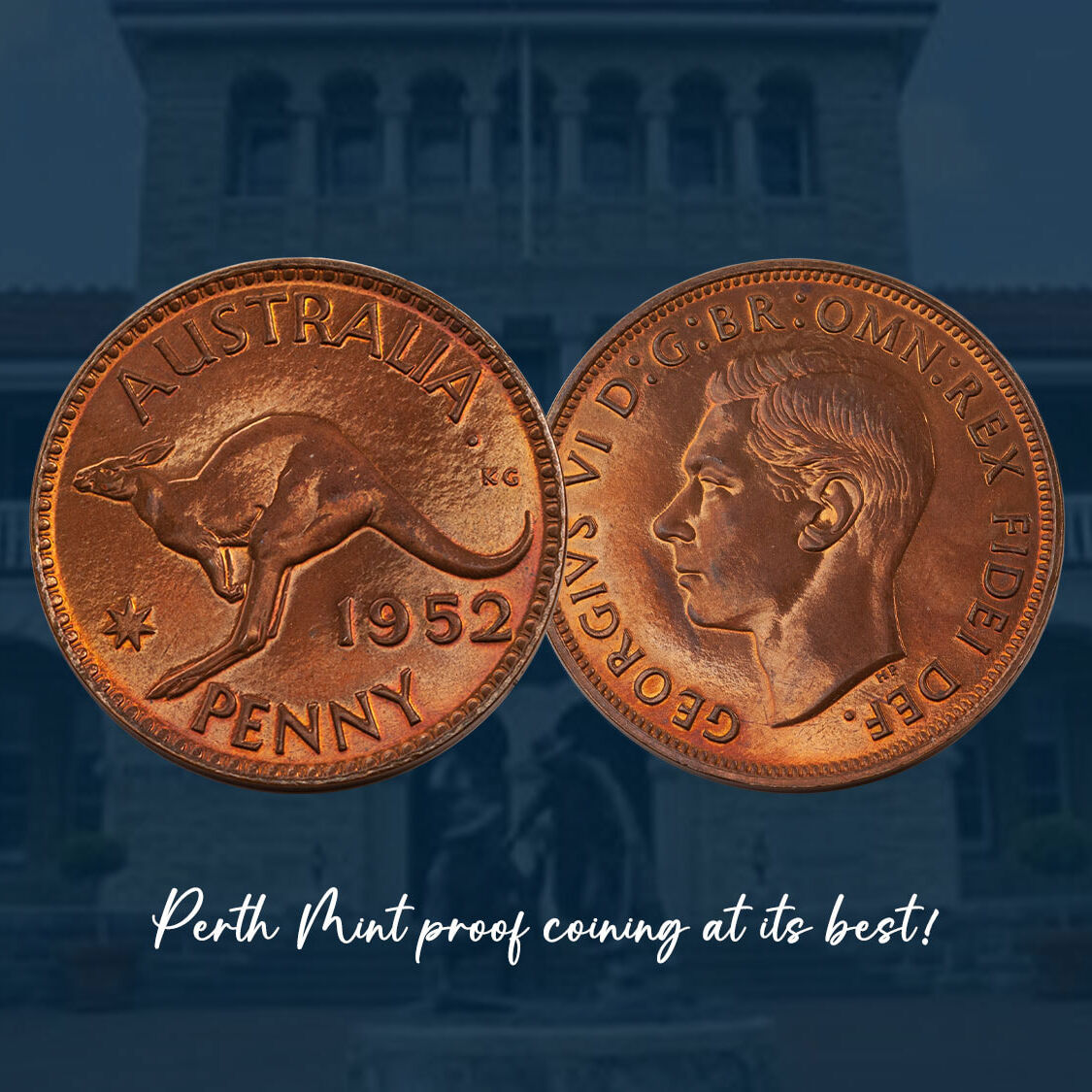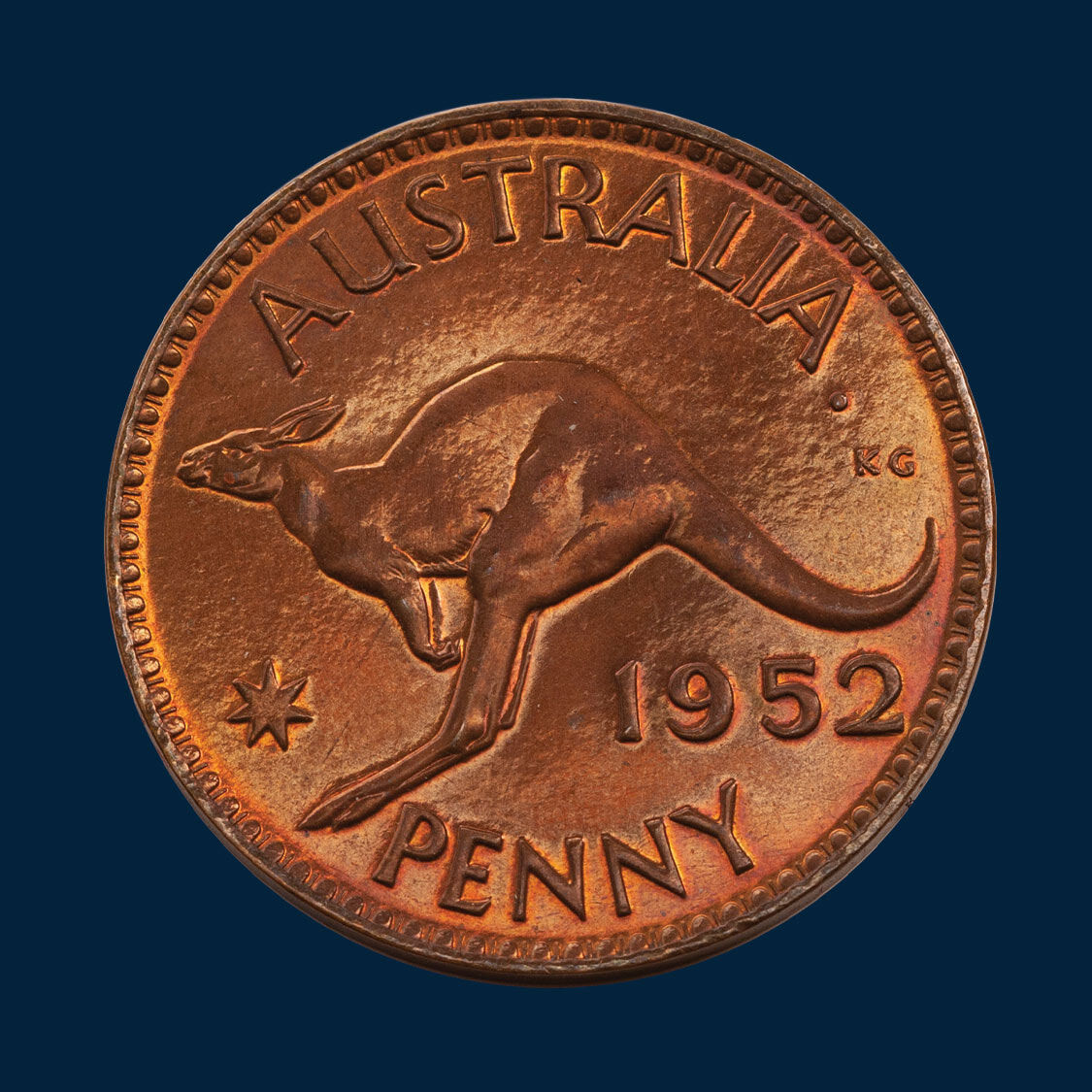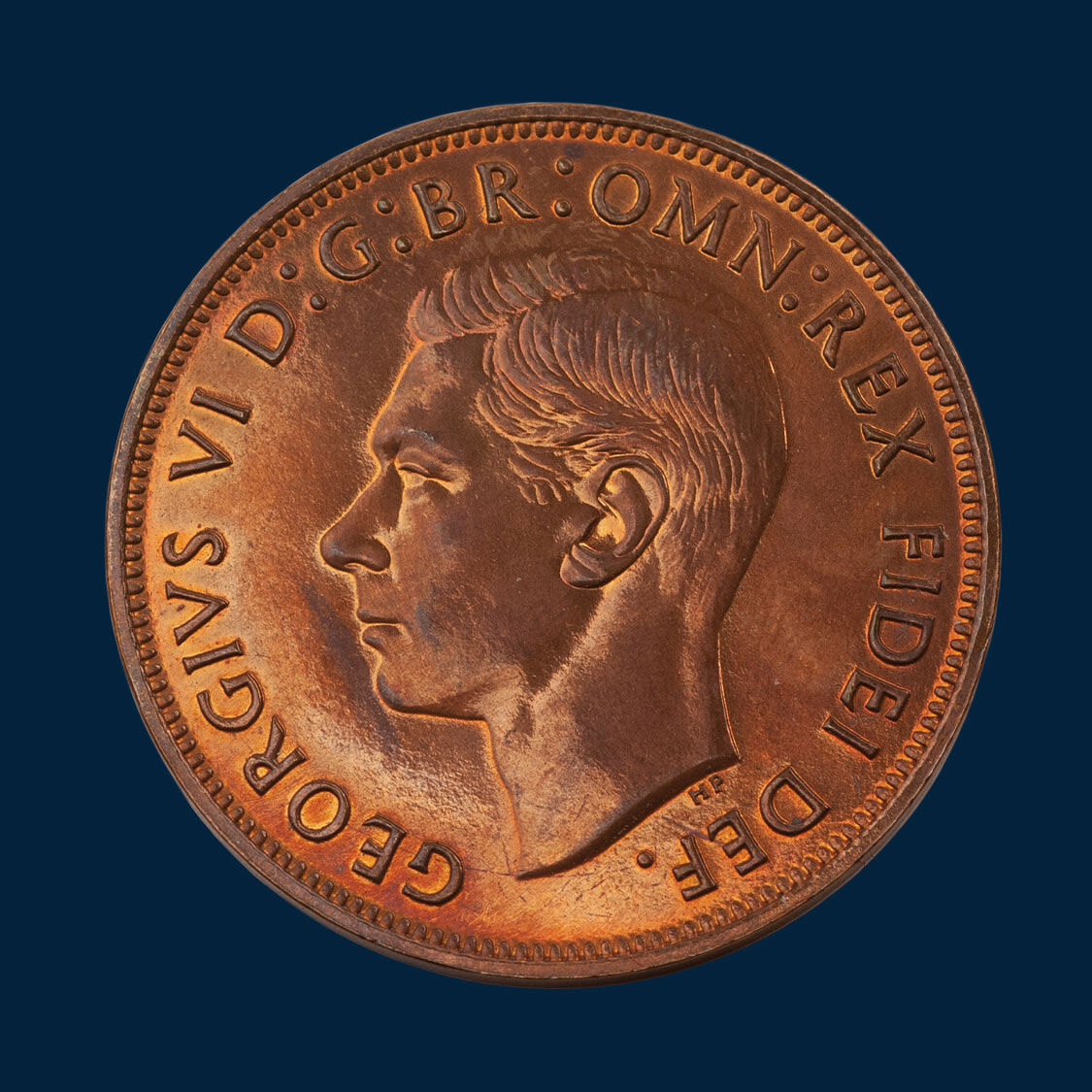Proof 1952 Penny struck as a Coin of Record at the Perth Mint

This is an extraordinary quality Perth Mint Proof 1952 Penny. In our view it is the absolute finest of the known examples. The fields are like molten copper, super-reflective. The edges are polished, the denticles pristine. The coin simply dazzles. This is Perth Mint proof coining at its best. Furthermore, the coin is rare as are all Perth Mint proofs out of this era. The original mintage was fifteen with the majority sent to museums leaving few for collectors. The coin certainly impressed the crowd when it first appeared at auction in 2013. Solid bidding took the price from its pre-sale estimate of $20,000 to a final knockdown of $34,000, seventy per cent over the anticipated sale price. While we might sight a Proof 1952 Penny on the market every three to four years this coin, as the finest of its year, is a once in a lifetime buying opportunity.
In an article published in the Journal of the Numismatic Association of Australia 2005, renowned numismatist Paul Holland contends that the Perth Mint proofs seemed to have been created for unaided vision. The point here is that a collector would not need an eye-glass to take in their beauty.
He also contends that the Royal Mint's 1951 proofs from the Royal Mint London came to be viewed as the best possible model for what the Perth Mint bronze proofs should look like. (Royal Mint's 1951 copper proofs, as a general rule, are stunning. Visually impactful.) When you look at this Proof 1952 Penny you can't help but feel that Holland was spot-on with his assessment.

1952 Proof Penny
Perth Mint Coin of Record

1952 Proof Penny
Perth Mint Coin of Record
The rarity of the Proof 1952 Penny was confirmed in 1995 in an article published in the NAA journal (Volume 8) by John Sharples, the then Curator of Australia’s Numismatic Archives.
He examined the distribution of proof coins recorded in Perth Mint communications and records over the period 1940 – 1954. He found evidence that fifteen proof pennies were struck at the Perth Mint in 1952.
The majority of the mintage was sent to Public Collections and Numismatic Societies. The official list authorised to receive Perth proofs were the Australian War Memorial, Royal Mint London, British Museum, Royal Mint Melbourne, Japan Mint, National Gallery SA, Art Gallery WA, National Gallery Victoria, Victorian Numismatic Society, South Australian Numismatic Society and the Australian Numismatic Society.
He noted that two private collectors (most likely Syd Hagley and Ray Jewell) received examples of the pre-1955 proof coins, such was the influence of these collectors.
The balance of the mintage, was destined for the mint's own archives. That
the bulk of the mintage was gifted to institutions is the very reason why they are so rare in today's collector market.
We might sight a Proof 1952 Penny on the market every three to four years. One as spectacular as this is a once-in-a-lifetime buying opportunity.
Proof 1952 Penny struck as a Coin of Record at the Perth Mint, FDC and a brilliant, full original mint red
Nobles Auction April 2013, lot 1472
$40,000
This is an extraordinary quality Perth Mint Proof 1952 Penny and, in our view, the absolute finest of the known examples. The fields are like molten copper, super-reflective. The edges are polished, the denticles pristine.
The coin simply dazzles. This is Perth Mint proof coining at its best. Furthermore, the coin is rare as are all Perth Mint proofs out of this era. The original mintage was fifteen with the majority sent to museums leaving few for collectors. The coin certainly impressed the crowd when it first appeared at auction in 2013.
Solid bidding took the price from its pre-sale estimate of $20,000 to a final knockdown of $34,000, seventy per cent over the anticipated sale price. While we might sight a Proof 1952 Penny on the market every three to four years this coin, as the finest of its year, is a once in a lifetime buying opportunity.
Proof 1952 Penny struck as a Coin of Record at the Perth Mint, FDC and a brilliant, full original mint red
Nobles Auction April 2013, lot 1472
$40,000
This is an extraordinary quality Perth Mint Proof 1952 Penny and, in our view, the absolute finest of the known examples. The fields are like molten copper, super-reflective. The edges are polished, the denticles pristine.
The coin simply dazzles. This is Perth Mint proof coining at its best. Furthermore, the coin is rare as are all Perth Mint proofs out of this era. The original mintage was fifteen with the majority sent to museums leaving few for collectors. The coin certainly impressed the crowd when it first appeared at auction in 2013.
Solid bidding took the price from its pre-sale estimate of $20,000 to a final knockdown of $34,000, seventy per cent over the anticipated sale price. While we might sight a Proof 1952 Penny on the market every three to four years this coin, as the finest of its year, is a once in a lifetime buying opportunity.
Apart from its extreme rarity, we offer four sound reasons why this Proof 1952 Penny is a must-have for today's collector.
1. Brilliantly preserved proof coins of the Perth Mint are unrivalled for quality.
The coins not only display superb levels of detail in their design, but qualities and colours that are unmatched by those of the Melbourne Mint. Each coin is a work of art, as individual, and as beautiful, as an opal. This Proof 1952 Penny looks like molten copper. It is magnificent.
2. Proof coins have a wonderful connection to the past.
They are the story tellers, defining an era, or a year, like no other coin. Proofs can also define an occasion. And a monarch. And they tend to have a connection to a prominent person, either a dignitary, a Mint Master or an influential collector. The Proof 1952 Penny is the last proof penny struck with the portrait of George VI.
3. Collectors are all but guaranteed that the market will never be flooded with examples.
The Perth Mint Proof Record Pieces is a sector of the rare coin market that offers financial stability and has been the hunting ground of investors for decades. The sector also has strength because it has widespread support amongst the Australian dealer market.
4. The Perth Mint is still operating.
That the Perth Mint is a leading coin producer makes their pre-decimal proofs historical. But also vibrantly current. So the ‘Perth Mint’ message always remains strong, underpinning future interest.
History of the Perth Mint
The discovery of vast gold fields in Coolgardie in 1892 and Kalgoorlie in 1893 triggered a Gold Rush in Western Australia and convinced the British Government to authorise the opening of a mint in Perth.
It was the third branch of the Royal Mint London opened in Australia following the establishment of the Sydney Mint in 1855 and the Melbourne Mint in 1872.
The Perth Mint was established in 1899 and remained a gold producing mint from the year of its opening until 1931 when Australia struck its last sovereign.
For nine years, the coining presses at the Perth Mint ground to a halt. Then early in November 1940, the Australian Government requested Perth to undertake the coining of Australia’s bronze pennies and halfpennies.
The Melbourne Mint had been called upon to do munitions work during World War II and assistance was sought from the Perth Mint to meet Australia’s currency requirements.
The Perth Mint continued to strike copper coins until 1964, when two years later Australia converted to decimal currency.
Established as a branch of the Royal Mint London, the Perth Mint adopted the practices of its master and struck proofs of those coins being struck for circulation.
In accordance with minting traditions the Perth Mint struck proof record pieces of those coins being struck for circulation. There was no hint of commercialism in the production of these pieces.
Posterity, the preservation of Australia’s coining heritage … that and a passion for numismatics were the driving forces behind their striking. The collector market per se was denied access to the coins.
When the Perth Mint struck a proof penny, its intention was to create a single, copper masterpiece. Coining perfection. Perfection in the dies. Wire brushed so that they were razor sharp. Perfection in the design, highly detailed, expertly crafted. Perfection in the fields, achieved by hand selecting unblemished blanks, polished to create a mirror shine.
Perfection in the edges to encase the design … exactly what a picture frame does to a canvas. A proof coin was never intended to be used in every-day use, tucked away in a purse. Or popped into a pocket.
Proof coins were struck to be preserved in the mint's archives as a record of Australia’s coining history, time-capsuled for future generations. Proof coins were also used to showcase a mint’s coining skills, to display at major worldwide Exhibitions or sent to other mint’s and public institutions.
The rarity of the Perth Mint proofs was confirmed in 1995 in an article published in the NAA journal (Volume 8) by John Sharples, the then Curator of Australia’s Numismatic Archives. He examined the distribution of proof coins recorded in Perth Mint communications and records over the period 1940 – 1954. He noted that two private collectors (most likely Syd Hagley and Ray Jewell) received examples of the pre-1955 proof coins, such was the influence of these collectors.
The balance of the mintage, however, was destined for the mint's own archives with the majority sent to Public Collections and Numismatic Societies. The official list authorised to receive Perth proofs were the Australian War Memorial, Royal Mint London, British Museum, Royal Mint Melbourne, Japan Mint, National Gallery SA, Art Gallery WA, National Gallery Victoria, Victorian Numismatic Society, South Australian Numismatic Society and the Australian Numismatic Society.
That the bulk of the mintage was gifted to institutions is the very reason why they are so rare in today's collector market.
© Copyright: Coinworks